Numerical Analysis of Load Reduction in the Gliding Process Achieved by the Bionic Swan’s Webbed-Foot Structures
Abstract
1. Introduction
2. Three-Dimensional Model and Basic Assumptions of Swan’s Water Entry
2.1. Basic Considerations and Assumptions
2.2. Three-Dimensional Modeling of the Bionic Webbed Foot and the Coordinate System’s Definition
3. Numerical Calculation Method
3.1. Governing Equations and Turbulence Model
3.2. Global Motion Mesh Technology and 6-Degrees-of-Freedom Motion Model
3.3. Computational Domain and Boundary Conditions
3.4. Mesh Independence Verification
3.5. Validation of Numerical Methods
4. Results Analysis and Discussion
4.1. Motion Characteristics and Flow-Field Analysis of Bionic Swan Webbed Foot During Typical Water-Entry Process
4.2. Influence of Initial Motion Parameters on Bionic Webbed Foot’s Motion Characteristics
4.2.1. Effect of Initial Velocity
4.2.2. Influence Mechanism of Initial Pitch Angle
4.2.3. Influence of Initial Water-Entry Velocity Angle
4.2.4. Analysis of Initial Motion Parameters on Dynamic Stability
5. Summary
- (1)
- The near-surface gliding motion of the bionic webbed foot can be divided into two typical stages: stable skipping and surface gliding. In the stable skipping stage, the impact load, vertical displacement, and horizontal velocity of the bionic webbed foot show significant periodic fluctuations. In this process, the bionic webbed foot is subjected to a high impact load when impacting the water, a localized high-pressure zone is formed in the contact area of the water body, and the kinetic energy is transferred to the water body in the form of pressure and gradually dissipated. During the water surface-gliding stage, the webbed foot is continuously subjected to the action of water body gliding resistance, and the speed shows a rapid decay trend. The kinetic mechanism of the bionic webbed foot’s water-gliding behavior can be summarized as follows: Through the progressive gliding resistance of the water body to the bionic flipper, the kinetic energy of the body is gradually dissipated, which avoids the situation of a high impact load due to the instantaneous release of energy when directly impacting with the water. This movement mechanism not only effectively reduces the peak impact load but also significantly improves the stability of the movement process.
- (2)
- The water-entry velocity significantly affects the motion pattern and kinetic characteristics of the bionic webbed foot’s gliding. When the water-entry velocity is lower than 6 m/s, the impact load is not enough to support the flippers to complete the gliding jump, so they show direct gliding into the water. When the water-entry velocity exceeds 8 m/s, the vertical impact load increases, and the phenomenon of gliding into the water after skipping occurs. With the increase in velocity, the bionic webbed foot is subjected to an enhanced impact load and leaves the water faster, which is manifested in an increase in the stabilized skipping and a prolongation of the distance of skipping.
- (3)
- The water-entry pitch angle mainly affects the motion attitude of the bionic webbed foot. As the pitch angle increases, the horizontal impact load increases while the vertical impact load decreases, and the pitching moment changes from positive to negative. When the pitch angle is 20°, the pitching moment amplitude is the smallest, and the motion attitude is the most stable. When the pitch angle is less than 15° or more than 25°, it causes the webbed foot to raise or lower its head rapidly, which is not conducive to stabilizing the slip-and-jump motion and may lead to vehicle motion instability or hitting the water, respectively.
- (4)
- The water-entry velocity angle has a significant effect on the dynamics of the first impact entry. It is shown that the increase in the water-entry velocity angle will lead to an increase in the vertical velocity component, which will aggravate the impact of the water body on the webbed foot, as evidenced by a significant increase in the peak value of the impact load and the amplitude of the pitching moment during the first water entry. Therefore, a smaller water-entry velocity angle is more favorable to enhance the load reduction effect and motion stability of water gliding. This finding provides an important basis for the optimal design of the bionic webbed-foot motion parameters, indicating that more efficient kinetic energy dissipation and a more stable gliding motion can be achieved by reasonably controlling the water-entry velocity angle.
Supplementary Materials
Author Contributions
Funding
Institutional Review Board Statement
Informed Consent Statement
Data Availability Statement
Conflicts of Interest
Abbreviations
| CMV | Cross-Medium Vehicle |
| CFD | Computational Fluid Dynamics |
| GMM | Global Motion Mesh |
| UAV | Unmanned Aerial Vehicle |
| RANS | Reynolds-Averaged Navier–Stokes |
| VOF | Volume of Fluid |
| 6DOF | Six Degrees of Freedom |
References
- Xie, H.; Jin, Y.; Bi, Y.; Zeng, Z. Nezha-D: Dynamic Characteristics and Design of a Ducted HAUV. J. Intell. Robot. Syst. 2025, 111, 20. [Google Scholar] [CrossRef]
- Yao, G.; Li, Y.; Zhang, H.; Jiang, Y.; Wang, T.; Sun, F.; Yang, X. Review of hybrid aquatic-aerial vehicle (HAAV): Classifications, current status, applications, challenges and technology perspectives. Prog. Aerosp. Sci. 2023, 139, 100902. [Google Scholar] [CrossRef]
- Zeng, Z.; Lyu, C.; Bi, Y.; Jin, Y.; Lu, D.; Lian, L. Review of hybrid aerial underwater vehicle: Cross-domain mobility and transitions control. Ocean Eng. 2022, 248, 110840. [Google Scholar] [CrossRef]
- Jin, Y.; Bi, Y.; Lyu, C.; Bai, Y.; Zeng, Z.; Lian, L. Nezha-IV: A hybrid aerial underwater vehicle in real ocean environments. J. Field Robot. 2024, 41, 420–442. [Google Scholar] [CrossRef]
- Lu, M.; Tu, M.; Liao, F.; Wu, S.; Xing, B.; Fan, Z.; Su, Y.; Wu, W. NDO-enhanced adaptive fixed-time prescribed performance sliding mode tracking control for coaxial cross-domain flying buoys under unknown ocean disturbances. Ocean Eng. 2025, 321, 120297. [Google Scholar] [CrossRef]
- Li, W.; Wu, W.; Miao, Q.; Wu, J. Research on the Overall Design and Water Entry Simulation of Cross-Media Unmanned Underwater Vehicles. J. Mar. Sci. Eng. 2025, 13, 78. [Google Scholar] [CrossRef]
- Liu, X.; Tan, L.; Zhang, X.; Li, L. Research of Slamming Load Characteristics during Trans-Media Aircraft Entry into Water. Drones 2024, 8, 89. [Google Scholar] [CrossRef]
- Peng, T.; Peng, Y.; Sun, P.; Liu, N.; Li, S. Mitigating impact loads during water entry by utilizing the air-spring effect. Ocean Eng. 2024, 308, 118260. [Google Scholar] [CrossRef]
- Chen, Y.; Ren, T.; Wei, J. Launch characteristics of autonomous underwater vehicle into water and suction characteristics of tail propeller in near free liquid position. Phys. Fluids 2024, 36, 114118. [Google Scholar] [CrossRef]
- Liu, Y.; Lei, M.; Xu, H.; Liu, T.; Tian, B. Structure Parameter Effect on Skipping Movement Characteristics of Trans-Media Aircraft Near-Water Surface. Trans. Beijing Inst. Technol. 2024, 44, 937–946. [Google Scholar] [CrossRef]
- Gao, Y.; Zhang, H.; Li, G.; Zhou, M.; Yin, H.; Gulliver, T.A. Analysis of trans-domain motion process of bullet-shaped trans-domain amphibious vehicle. J. Field Robot. 2024, 41, 68–92. [Google Scholar] [CrossRef]
- Clifton, G.T.; Hedrick, T.L.; Biewener, A.A. Western and Clark’s grebes use novel strategies for running on water. J. Exp. Biol. 2015, 218, 1235–1243. [Google Scholar] [CrossRef] [PubMed]
- Sharker, S.I.; Holekamp, S.; Mansoor, M.M.; Fish, F.E.; Truscott, T.T. Water entry impact dynamics of diving birds. Bioinspir. Biomim. 2019, 14, 056013. [Google Scholar] [CrossRef] [PubMed]
- Whitehead, J.G.; Worrell, T.; Socha, J.J. Mallard landing behavior on water follows a-constant braking strategy. J. Exp. Biol. 2023, 226, 244256. [Google Scholar] [CrossRef]
- Guo, D.; Bacciaglia, A.; Simpson, M.; Bil, C.; Marzocca, P. Design and development a bimodal unmanned system. In Proceedings of the AIAA Scitech 2019 Forum, San Diego, CA, USA, 7–11 January 2019; p. 2096. [Google Scholar]
- Wang, X.; Zhao, J.; Pei, X.; Wang, T.; Hou, T.; Yang, X. Bioinspiration review of Aquatic Unmanned Aerial Vehicle (AquaUAV). Biomim. Intell. Robot. 2024, 4, 100154. [Google Scholar] [CrossRef]
- Young, P. Swan; Reaktion Books: London, UK, 2008. [Google Scholar]
- Mclean, C.J.; Brassey, C.A.; Seiter, M.; Garwood, R.J.; Gardiner, J.D. The kinematics of amblypygid (Arachnida) pedipalps during predation: Extreme elongation in raptorial appendages does not result in a proportionate increase in reach and closing speed. J. Exp. Biol. 2024, 227, 246654. [Google Scholar] [CrossRef]
- Gibbs, B.J.; Akanyeti, O.; Liao, J.C. Kinematics and muscle activity of pectoral fins in rainbow trout (Oncorhynchus mykiss) station holding in turbulent flow. J. Exp. Biol. 2024, 227, 246275. [Google Scholar] [CrossRef]
- Menzer, A.; Ren, Y.; Guo, J.; Tobalske, B.W.; Dong, H. Wing kinematics and unsteady aerodynamics of a hummingbird pure yawing maneuver. Biomimetics 2022, 7, 115. [Google Scholar] [CrossRef]
- Sharma, D.; Erriguible, A.; Amiroudine, S. Numerical modeling of the impact pressure in a compressible liquid medium: Application to the slap phase of the locomotion of a basilisk lizard. Theor. Comput. Fluid Dyn. 2017, 31, 281–293. [Google Scholar] [CrossRef]
- Wang, Z.; Peng, W.; Zhang, B. Kinematics Analysis and Gait Study of Bionic Turtle Crawling Mechanism. Biomimetics 2024, 9, 147. [Google Scholar] [CrossRef]
- Chen, G.; Wei, N.; Li, J.; Lu, H. Design and simulation analysis of a bionic ostrich robot. Biomech. Model. Mechanobiol. 2022, 21, 1781–1801. [Google Scholar] [CrossRef] [PubMed]
- Huang, J.; Liang, J.; Yang, X.; Chen, H.; Wang, T. Cormorant Webbed-feet Support Water-surface Takeoff: Quantitative Analysis via CFD. J. Bionic Eng. 2021, 18, 1086–1100. [Google Scholar] [CrossRef]
- Wang, T.; Yang, X.; Liang, J.; Yao, G.; Zhao, W. CFD based investigation on the impact acceleration when a gannet impacts with water during plunge diving. Bioinspir. Biomim. 2013, 8, 036006. [Google Scholar] [CrossRef] [PubMed]
- Hou, T.; Yang, X.; Wang, T.; Liang, J.; Li, S.; Fan, Y. Locomotor transition: How squid jet from water to air. Bioinspir. Biomim. 2020, 15, 036014. [Google Scholar] [CrossRef]
- Deng, J.; Zhang, L.; Liu, Z.; Mao, X. Numerical prediction of aerodynamic performance for a flying fish during gliding flight. Bioinspir. Biomim. 2019, 14, 046009. [Google Scholar] [CrossRef]
- Dong, Y.; Liang, J.; Yang, X.; Huang, J.; Xue, X.; Fan, Y. Modeling and simulation of cormorant’s webbed-feet assisted take-off from water surface. In Proceedings of the 2017 IEEE International Conference on Robotics and Biomimetics (ROBIO), Macau, China, 5–8 December 2017; pp. 1659–1664. [Google Scholar]
- Ao, P.; Wang, X.; Meng, F.; Batbayar, N.; Moriguchi, S.; Shimada, T.; Koyama, K.; Park, J.; Kim, H.; Ma, M. Migration routes and conservation status of the Whooper Swan Cygnus cygnus in East Asia. Wildfowl 2020, 6, 43–72. Available online: https://www.researchgate.net/publication/348196853 (accessed on 1 July 2024).
- Guay, P.J.; Lorenz, R.D.; Robinson, R.W.; Symonds, M.R.; Weston, M.A. Distance from water, sex and approach direction influence flight distances among habituated black swans. Ethology 2013, 119, 552–558. [Google Scholar] [CrossRef]
- Hirt, C.W.; Nichols, B.D. Volume of fluid (VOF) method for the dynamics of free boundaries. J. Comput. Phys. 1981, 39, 201–225. [Google Scholar] [CrossRef]
- Jones, W.P.; Launder, B.E. The prediction of laminarization with a two-equation model of turbulence. Int. J. Heat Mass Transf. 1972, 15, 301–314. [Google Scholar] [CrossRef]
- Worthy, J.; Sanderson, V.; Rubini, P. Comparison of modified k-ε turbulence models for buoyant plumes. Numer. Heat Transf. Part B Fundam. 2001, 39, 151–165. [Google Scholar] [CrossRef][Green Version]
- Sarkar, S.; Lakshmanan, B. Application of a Reynolds stress turbulence model to the compressible shear layer. AIAA J. 1991, 29, 743–749. [Google Scholar] [CrossRef]
- Qu, Q.; Hu, M.; Guo, H.; Liu, P.; Agarwal, R.K. Study of ditching characteristics of transport aircraft by global moving mesh method. J. Aircr. 2015, 52, 1550–1558. [Google Scholar] [CrossRef]
- Schetz, J.A.; Bowersox, R.D. Boundary Layer Analysis; American Institute of Aeronautics and Astronautics: Reston, VA, USA, 2011. [Google Scholar]
- Rosellini, L.; Hersen, F.; Clanet, C.; Bocquet, L. Skipping stones. J. Fluid Mech. 2005, 543, 137–146. [Google Scholar] [CrossRef]

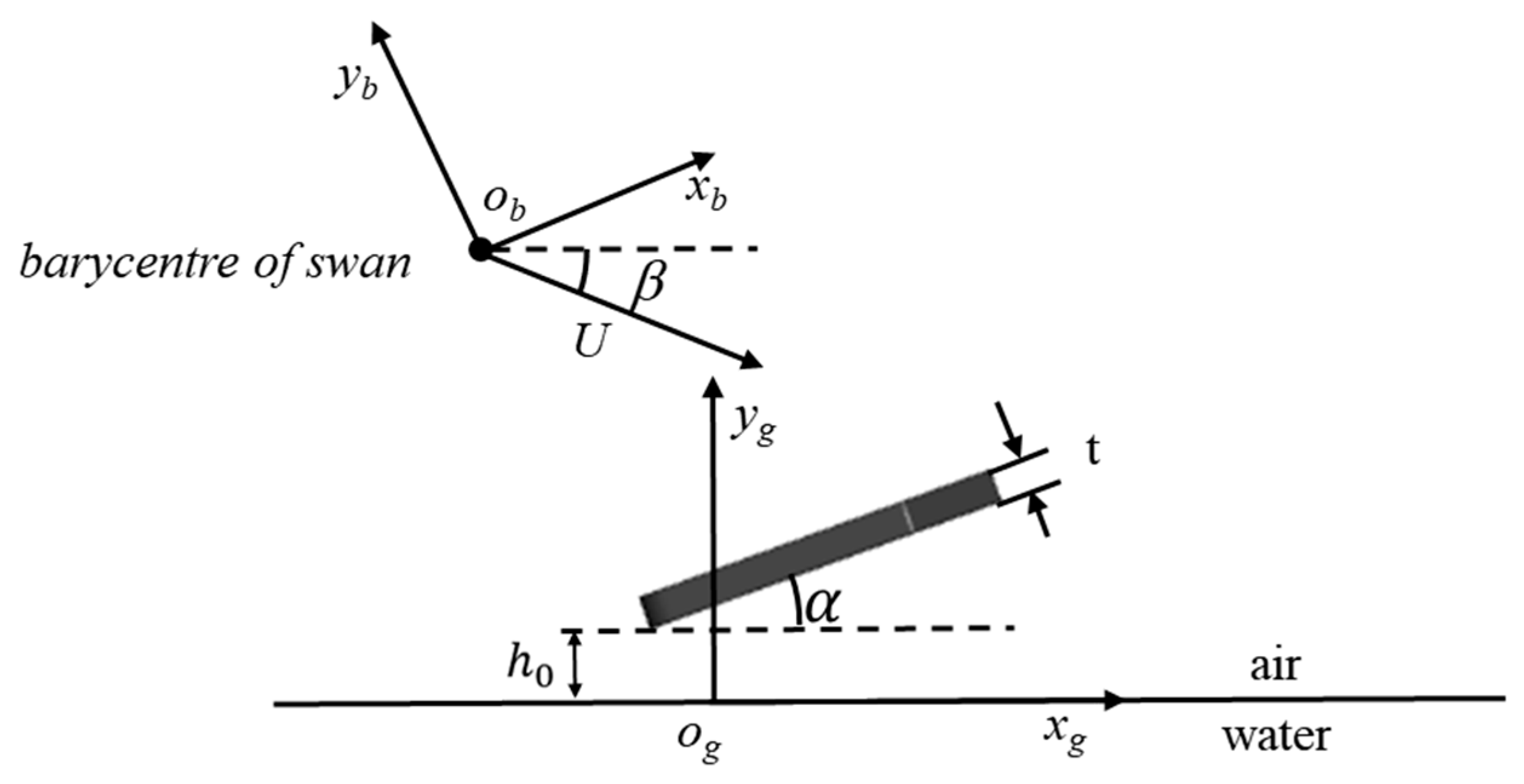
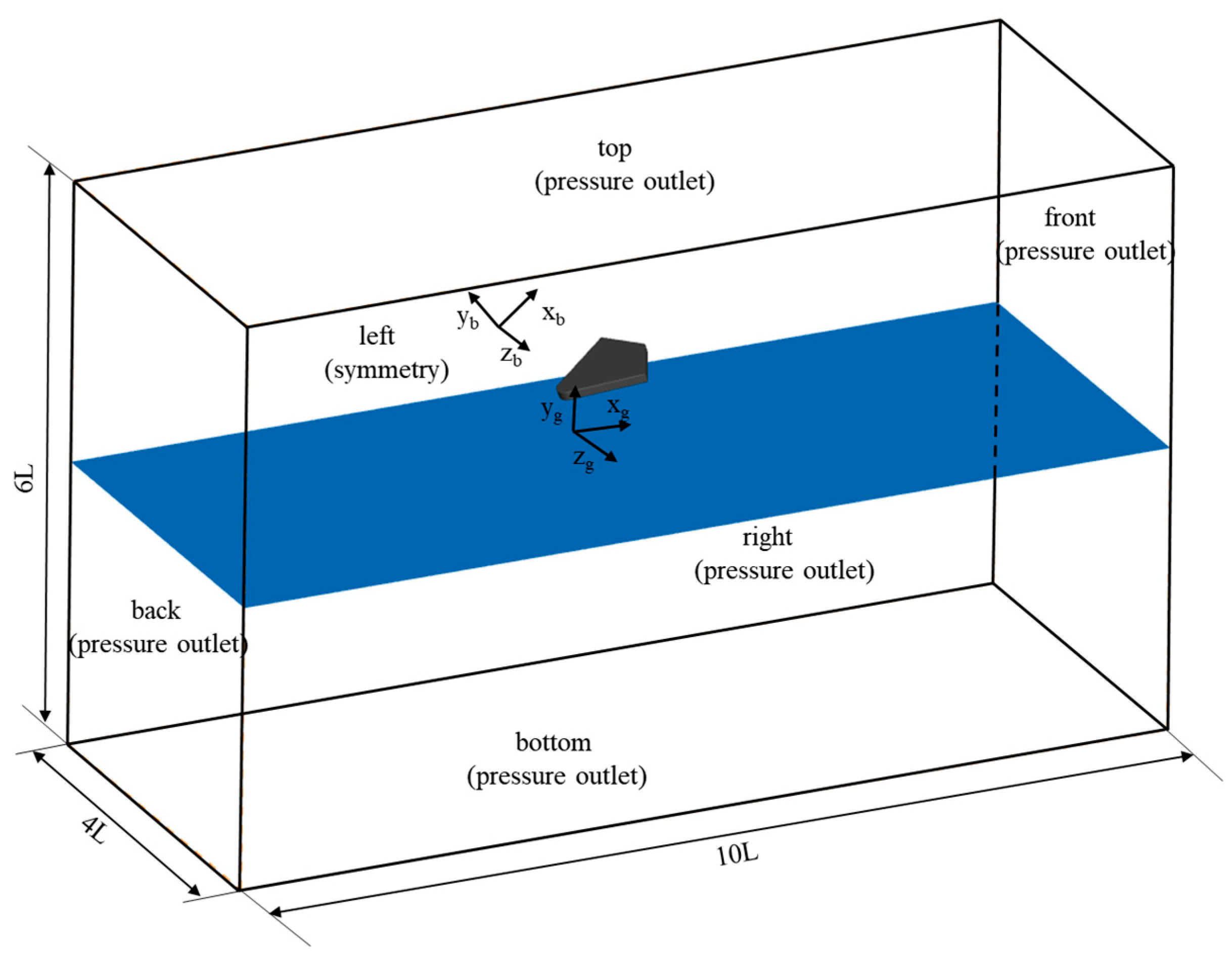


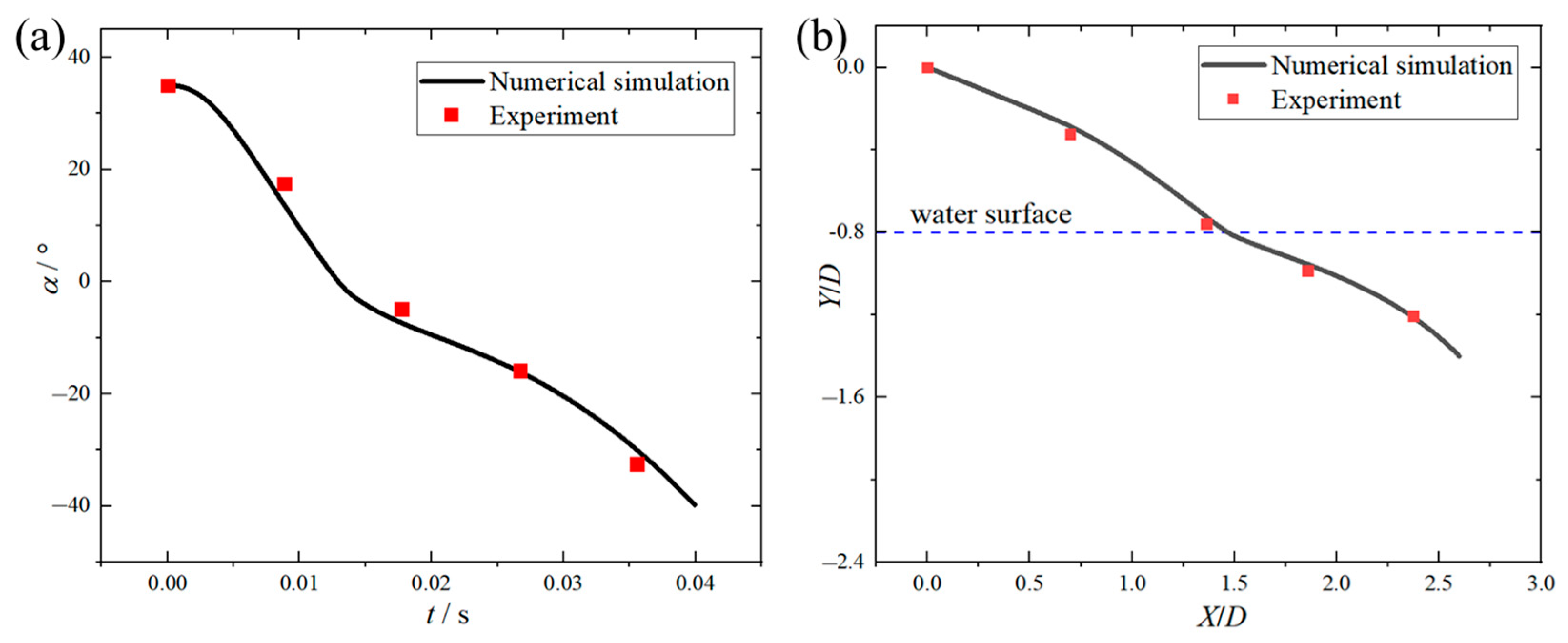
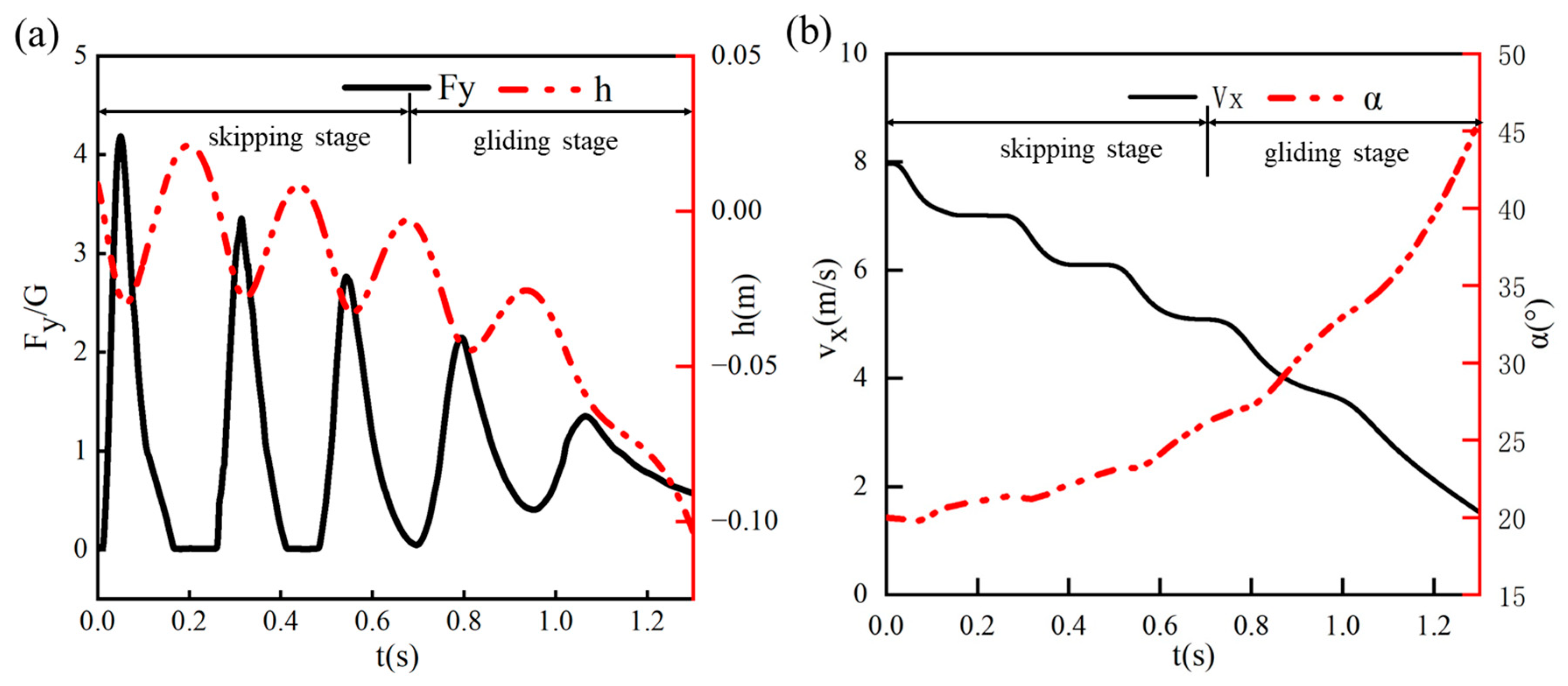

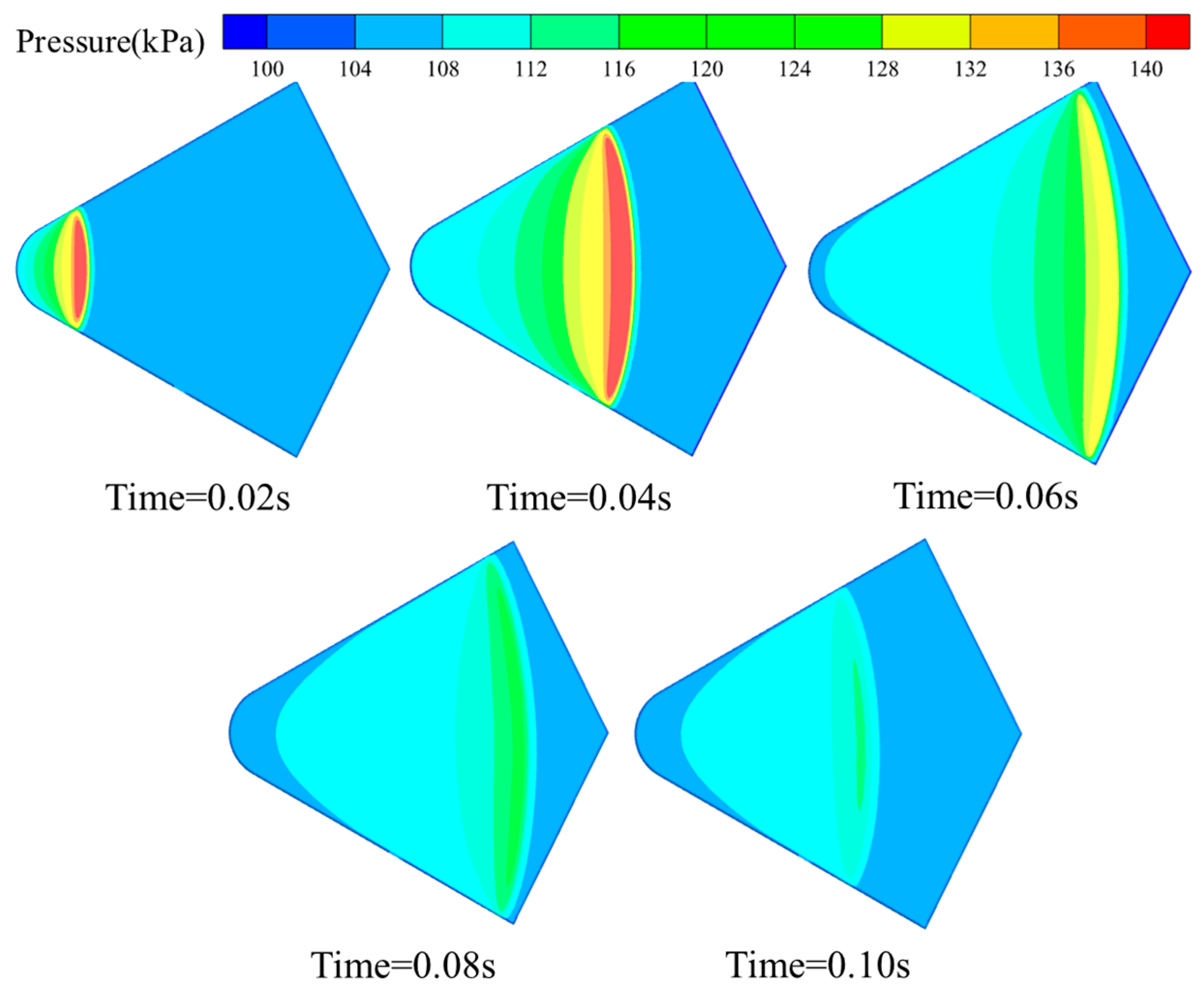
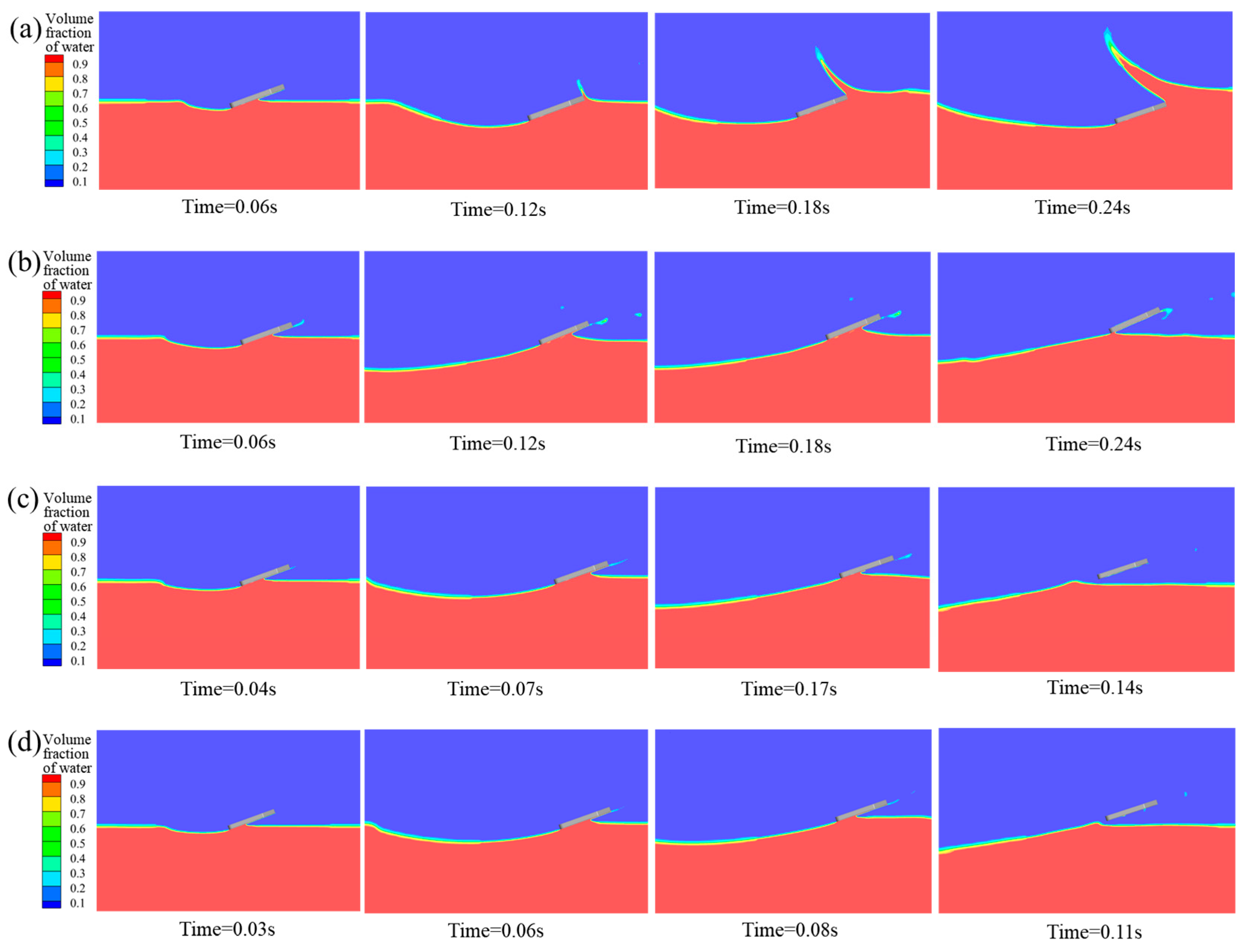
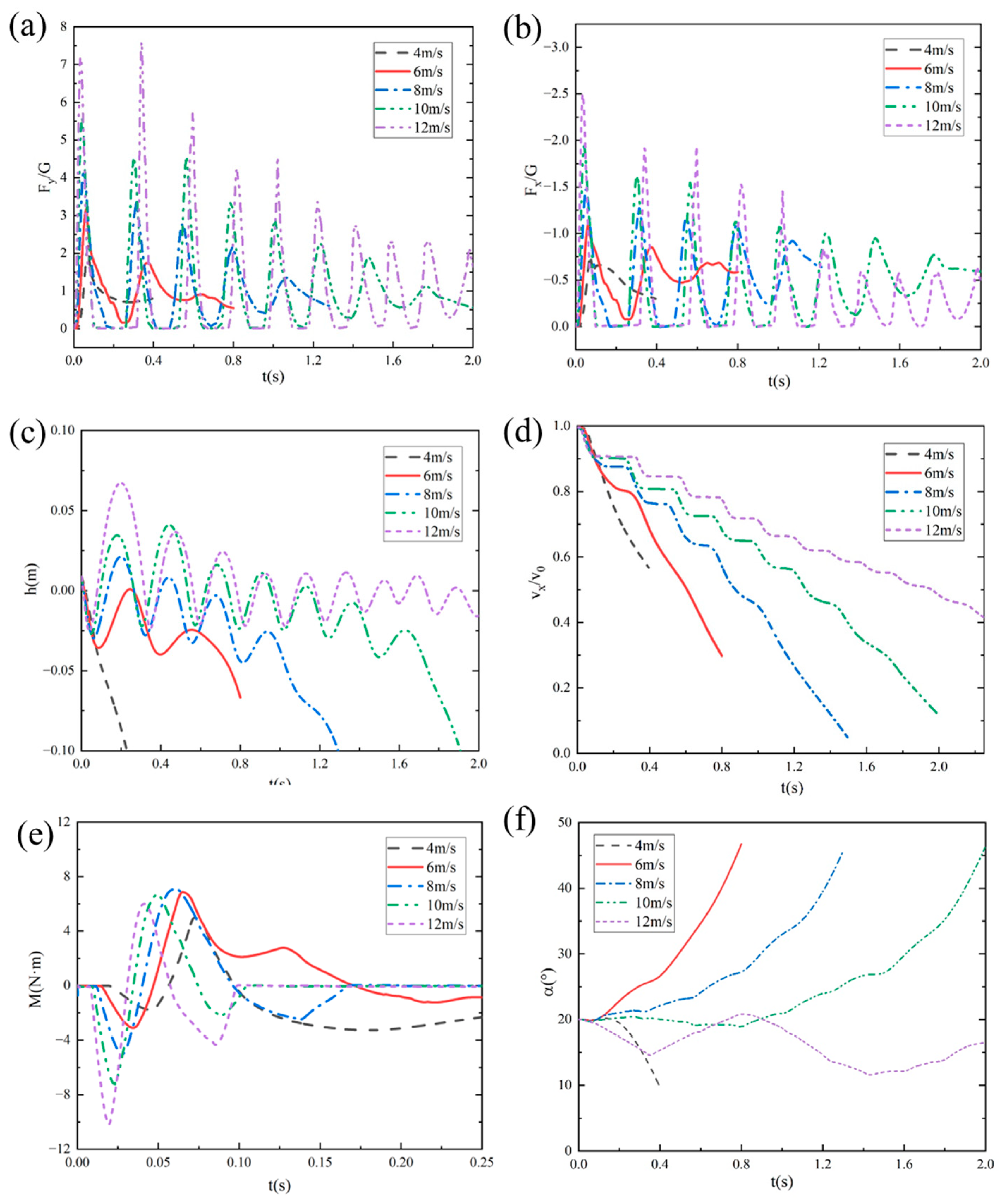


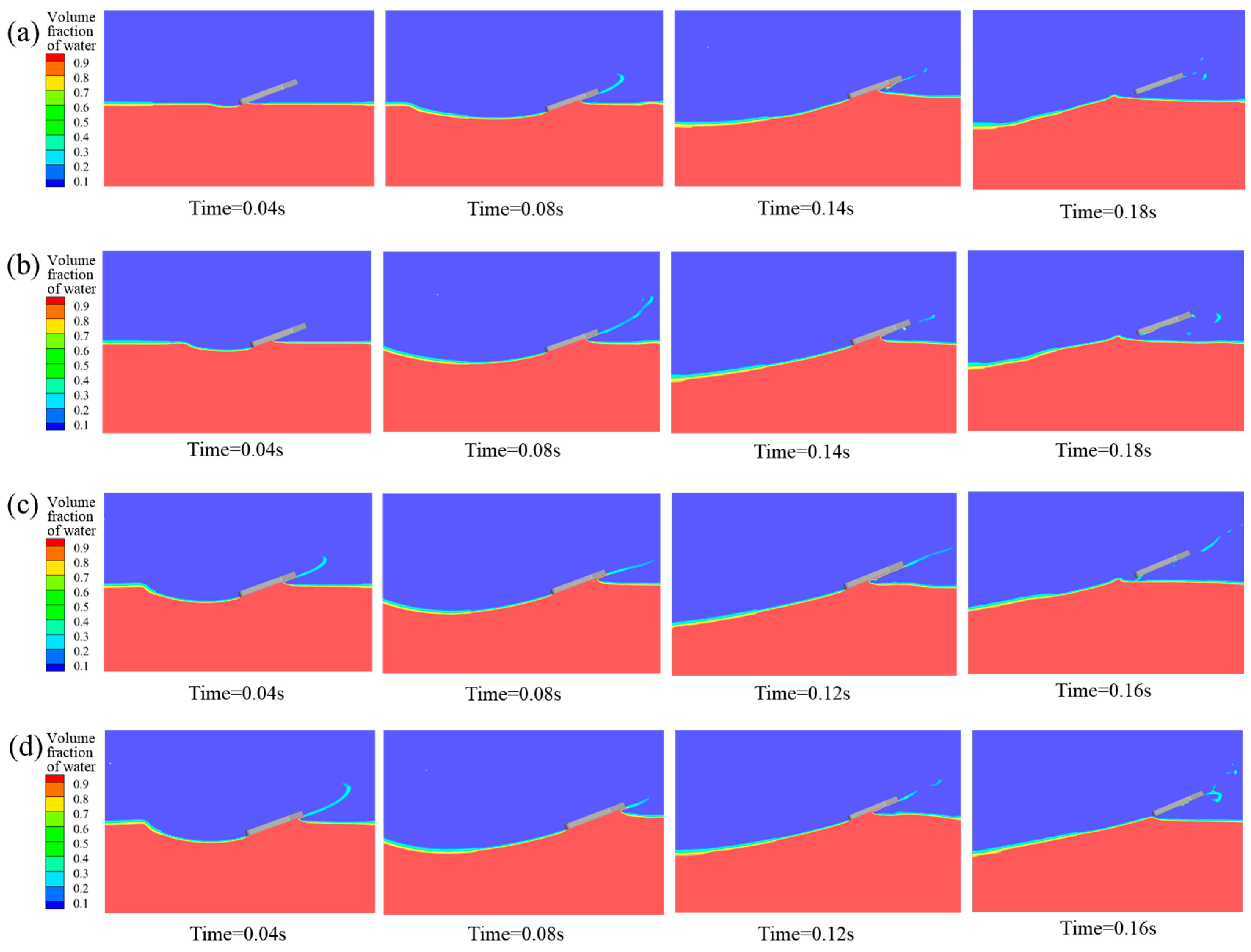
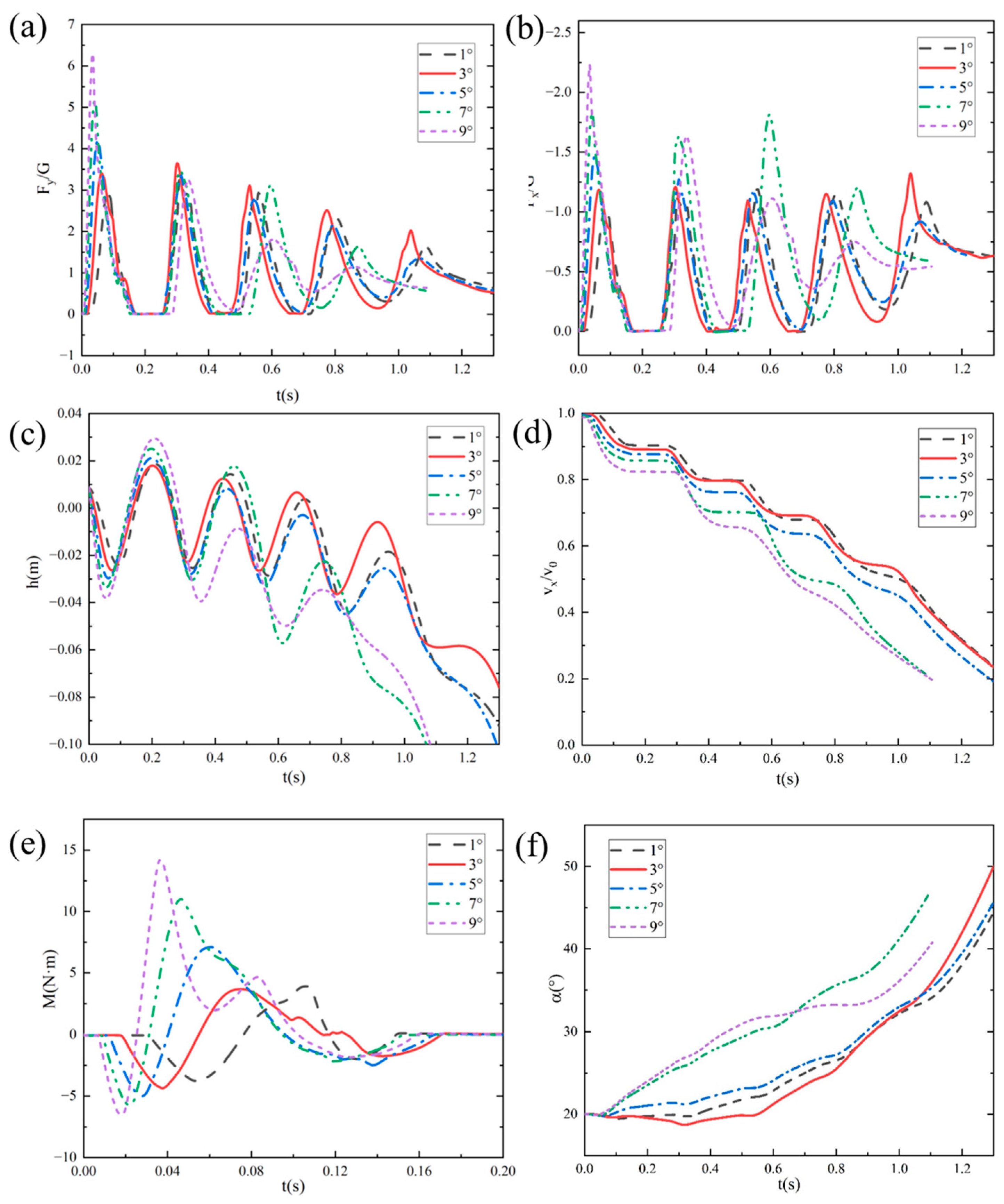
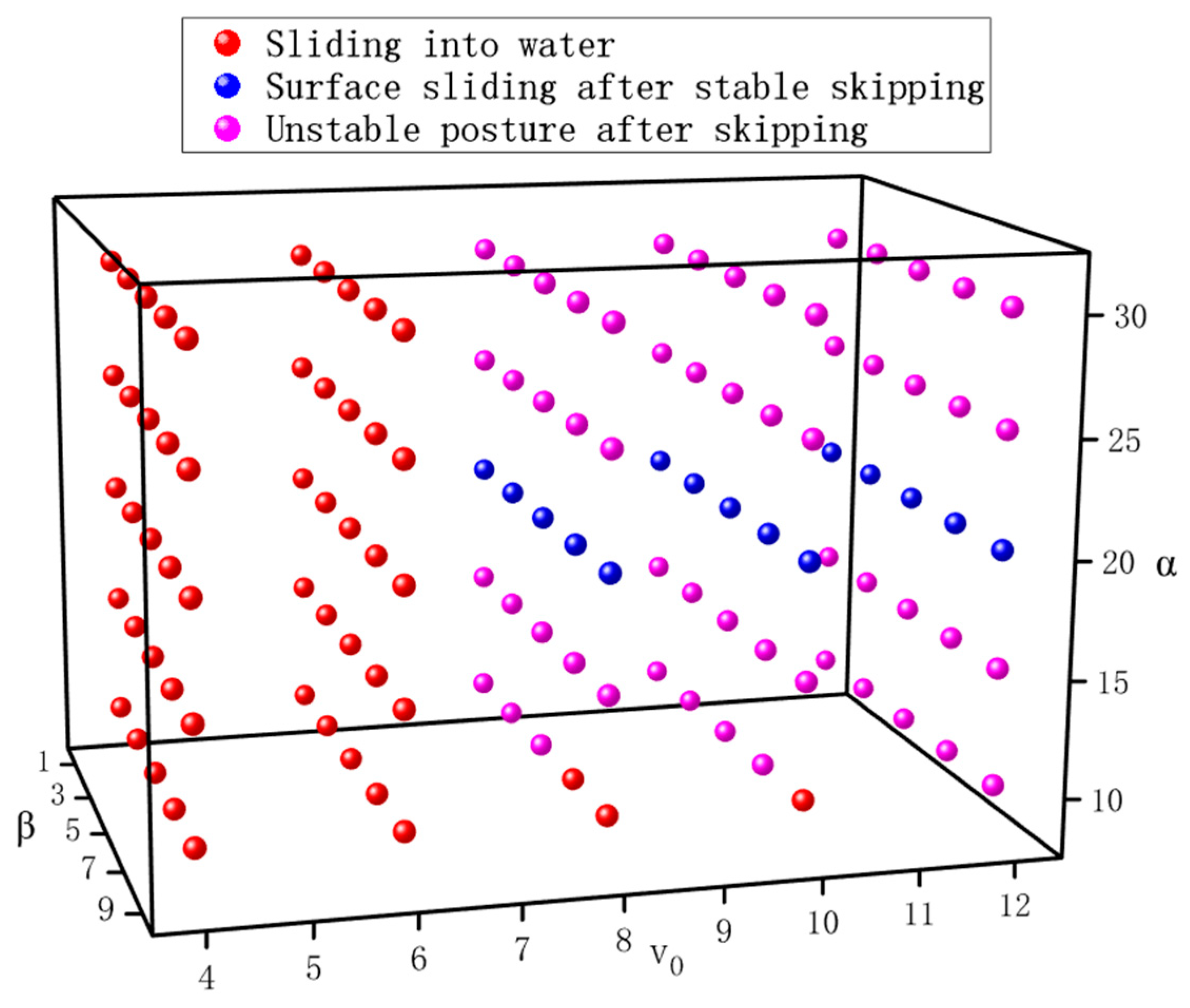
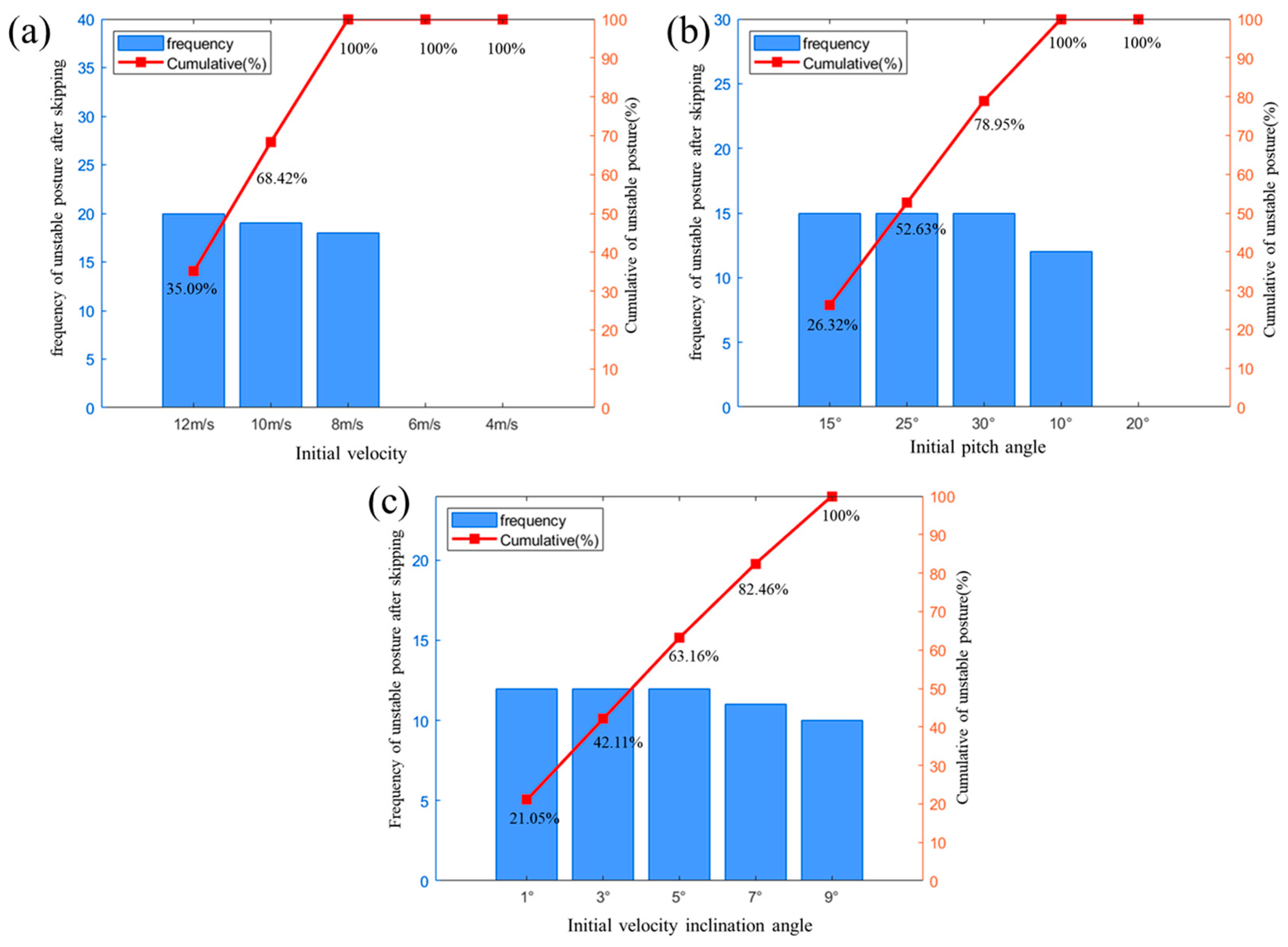
| Main Parameters | Symbols | Units | Quantitative Values |
|---|---|---|---|
| Length of the swan’s body | L | mm | 810 |
| Width of the swan’s body | D | mm | 260 |
| Length of the swan’s webbed foot | l | mm | 160 |
| Width of the swan’s webbed foot | d | mm | 170 |
| Weight of the swan | M | kg | 8 |
| Moment of inertia of the swan about the z-axis | IZZ | kg·m2 | 0.502 |
| Initial pitch angle of the swan’s webbed foot | α0 | ° | variable |
| Entry Velocity (m/s) | Skipping Frequency | Skipping Distance (m) |
|---|---|---|
| 8 m/s | 3 | 4.49 |
| 10 m/s | 5 | 8.81 |
| 12 m/s | 8 | 15.37 |
| Entry Velocity Angle (°) | Skipping Frequency | Skipping Distance (m) |
|---|---|---|
| 1° | 3 | 4.83 |
| 3° | 3 | 4.63 |
| 5° | 3 | 4.49 |
| 7° | 2 | 3.65 |
| 9° | 2 | 3.10 |
Disclaimer/Publisher’s Note: The statements, opinions and data contained in all publications are solely those of the individual author(s) and contributor(s) and not of MDPI and/or the editor(s). MDPI and/or the editor(s) disclaim responsibility for any injury to people or property resulting from any ideas, methods, instructions or products referred to in the content. |
© 2025 by the authors. Licensee MDPI, Basel, Switzerland. This article is an open access article distributed under the terms and conditions of the Creative Commons Attribution (CC BY) license (https://creativecommons.org/licenses/by/4.0/).
Share and Cite
Gao, F.; Liu, X.; Li, X.; Fan, Z.; Zhou, H.; Wu, W. Numerical Analysis of Load Reduction in the Gliding Process Achieved by the Bionic Swan’s Webbed-Foot Structures. Biomimetics 2025, 10, 405. https://doi.org/10.3390/biomimetics10060405
Gao F, Liu X, Li X, Fan Z, Zhou H, Wu W. Numerical Analysis of Load Reduction in the Gliding Process Achieved by the Bionic Swan’s Webbed-Foot Structures. Biomimetics. 2025; 10(6):405. https://doi.org/10.3390/biomimetics10060405
Chicago/Turabian StyleGao, Fukui, Xiyan Liu, Xinlin Li, Zhaolin Fan, Houcun Zhou, and Wenhua Wu. 2025. "Numerical Analysis of Load Reduction in the Gliding Process Achieved by the Bionic Swan’s Webbed-Foot Structures" Biomimetics 10, no. 6: 405. https://doi.org/10.3390/biomimetics10060405
APA StyleGao, F., Liu, X., Li, X., Fan, Z., Zhou, H., & Wu, W. (2025). Numerical Analysis of Load Reduction in the Gliding Process Achieved by the Bionic Swan’s Webbed-Foot Structures. Biomimetics, 10(6), 405. https://doi.org/10.3390/biomimetics10060405




